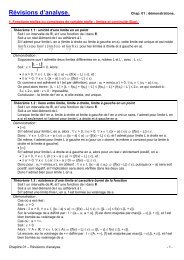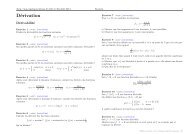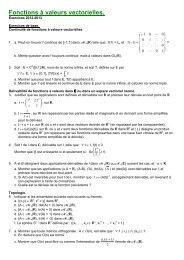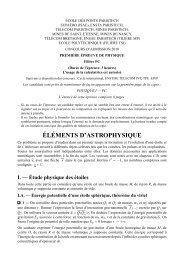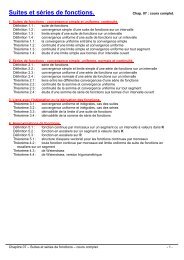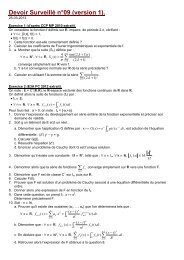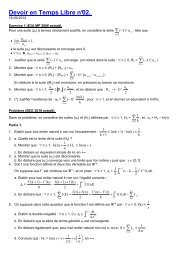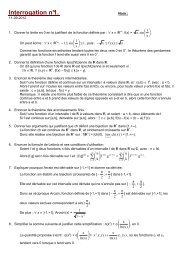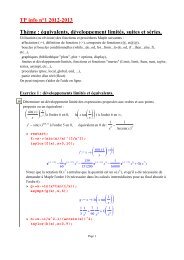Théorème de Weierstrass
Théorème de Weierstrass
Théorème de Weierstrass
Create successful ePaper yourself
Turn your PDF publications into a flip-book with our unique Google optimized e-Paper software.
[http://mp.cpgedupuy<strong>de</strong>lome.fr] édité le 26 juillet 2013 Enoncés 1<br />
<strong>Théorème</strong> <strong>de</strong> <strong>Weierstrass</strong><br />
Exercice 1 [ 01140 ] [correction]<br />
Soit f : [a, b] → C continue. Montrer<br />
b<br />
a<br />
f(t)e int dt −−−−−→<br />
n→+∞ 0<br />
On pourra commencer par étudier le cas où f est une fonction <strong>de</strong> classe C 1 .<br />
Exercice 2 [ 01141 ] [correction]<br />
Soit f : [0, 1] → R continue. Montrer que si pour tout n ∈ N,<br />
alors f est la fonction nulle.<br />
Exercice 3 [ 01142 ] [correction]<br />
1<br />
t n f(t) dt = 0<br />
0<br />
Soit f : [a, b] → R continue telle que b<br />
f(t) dt = 0. Montrer qu’il existe une suite<br />
a<br />
(Pn) <strong>de</strong> polynômes telle que<br />
b<br />
Exercice 4 [ 01143 ] [correction]<br />
a<br />
Pn(t) dt = 0 et sup |f(t) − Pn(t)| −−−−−→<br />
t∈[a,b]<br />
n→+∞ 0<br />
Soit f : [a, b] → R continue telle que f 0. Montrer qu’il existe une suite (Pn) <strong>de</strong><br />
polynômes telle que Pn 0 sur [a, b] et sup |f(t) − Pn(t)| −−−−−→<br />
t∈[a,b]<br />
n→+∞ 0.<br />
Exercice 5 [ 01144 ] [correction]<br />
Soit f : [a, b] → R <strong>de</strong> classe C 1 . Montrer qu’il existe une suite (Pn) <strong>de</strong> polynômes<br />
telle que<br />
N∞(f − Pn) → 0 et N∞(f ′ − P ′ n) → 0<br />
Exercice 6 [ 01145 ] [correction]<br />
[<strong>Théorème</strong> <strong>de</strong> <strong>Weierstrass</strong> : par les polynômes <strong>de</strong> Bernstein]<br />
Pour n ∈ N et k ∈ {0, . . . , n}, on pose<br />
<br />
n<br />
Bn,k(x) =<br />
k<br />
a) Calculer<br />
n<br />
Bn,k(x),<br />
k=0<br />
n<br />
kBn,k(x) et<br />
k=0<br />
b) Soient α > 0 et x ∈ [0, 1]. On forme<br />
Montrer que<br />
x k (1 − x) n−k<br />
n<br />
k 2 Bn,k(x)<br />
A = {k ∈ [[0, n]] / |k/n − x| α} et B = {k ∈ [[0, n]] / |k/n − x| < α}<br />
<br />
k∈A<br />
c) Soit f : [0, 1] → R continue. On pose<br />
fn(x) =<br />
k=0<br />
Bn,k(x) 1<br />
4nα 2<br />
n<br />
f<br />
k=0<br />
<br />
k<br />
Bn,k(x)<br />
n<br />
Montrer que (fn) converge uniformément vers f sur [0, 1].<br />
Exercice 7 [ 01146 ] [correction]<br />
[<strong>Théorème</strong> <strong>de</strong> <strong>Weierstrass</strong> : par convolution]<br />
n désigne un entier naturel.<br />
1. On pose<br />
1<br />
an =<br />
(1 − t<br />
−1<br />
2 ) n dt<br />
et on considère la fonction ϕn : [−1, 1] → R définie par<br />
ϕn(x) = 1<br />
a) Calculer 1<br />
0 t(1 − t2 ) n dt. En déduire que<br />
an =<br />
1<br />
−1<br />
(1 − x<br />
an<br />
2 ) n<br />
(1 − t 2 ) n dt 1<br />
n + 1<br />
Diffusion autorisée à titre entièrement gratuit uniquement - dD
[http://mp.cpgedupuy<strong>de</strong>lome.fr] édité le 26 juillet 2013 Enoncés 2<br />
b) Soit α ∈ ]0, 1]. Montrer que (ϕn) converge uniformément vers la fonction nulle<br />
sur [α, 1].<br />
2. Soit f une fonction continue <strong>de</strong> R vers R nulle en <strong>de</strong>hors <strong>de</strong> [−1/2, 1/2].<br />
a) Montrer que f est uniformément continue.<br />
On pose<br />
1<br />
fn(x) = f(x − t)ϕn(t) dt<br />
pour tout x ∈ R.<br />
b) Montrer que fn est une fonction polynomiale sur [−1/2, 1/2]<br />
c) Montrer que<br />
−1<br />
1<br />
f(x) − fn(x) = (f(x) − f(x − t))ϕn(t) dt<br />
d) En déduire que fn converge uniformément vers f sur R.<br />
3. Soit f une fonction réelle continue nulle en <strong>de</strong>hors <strong>de</strong> [−a, a].<br />
Montrer que f est limite uniforme d’une suite <strong>de</strong> polynômes.<br />
4. Soit f une fonction réelle continue sur [a, b].<br />
Montrer que f est limite uniforme d’une suite <strong>de</strong> polynômes.<br />
Exercice 8 Mines-Ponts MP [ 02828 ] [correction]<br />
Soit f ∈ C([a, b] , R). On suppose que pour tout n ∈ N,<br />
−1<br />
a) Montrer que la fonction f est nulle.<br />
b) Calculer<br />
+∞<br />
In =<br />
b<br />
x n f(x) dx = 0<br />
a<br />
0<br />
x n e −(1−i)x dx<br />
c) En déduire qu’il existe f dans C([0, +∞[ , R) non nulle, telle que, pour tout n<br />
dans N, on ait<br />
+∞<br />
x n f(x) dx = 0<br />
0<br />
Diffusion autorisée à titre entièrement gratuit uniquement - dD
[http://mp.cpgedupuy<strong>de</strong>lome.fr] édité le 26 juillet 2013 Corrections 3<br />
Corrections<br />
Exercice 1 : [énoncé]<br />
Cas f <strong>de</strong> classe C1 :<br />
<br />
<br />
b<br />
<br />
f(t)e<br />
<br />
int <br />
<br />
<br />
dt<br />
<br />
a<br />
|f(a)| + |f(b)|<br />
n<br />
+ 1<br />
n<br />
b<br />
|f ′ (t)| dt → 0<br />
Cas f continue :<br />
Pour tout ε > 0, il existe g : [a, b] → C <strong>de</strong> classe C1 tel que f − g∞ ε.<br />
On a alors<br />
<br />
<br />
b<br />
<br />
f(t)e<br />
<br />
int <br />
<br />
<br />
dt<br />
(b − a) f − g∞ +<br />
<br />
<br />
b<br />
<br />
g(t)e<br />
<br />
int <br />
<br />
<br />
dt<br />
<br />
donc pour n assez grand<br />
Par suite b<br />
a<br />
<br />
<br />
b<br />
<br />
f(t)e<br />
<br />
int <br />
<br />
<br />
dt<br />
(b − a)ε + ε<br />
<br />
a<br />
a<br />
f(t)e int dt −−−−−→<br />
n→+∞ 0<br />
Exercice 2 : [énoncé]<br />
Par le théorème <strong>de</strong> <strong>Weierstrass</strong>, il existe une suite (Pn) <strong>de</strong> fonction polynomiale<br />
telles N∞(Pn − f) → 0.<br />
On a alors<br />
1<br />
f 2 1<br />
1<br />
1<br />
(t) dt = f(t)(f(t) − Pn(t)) dt+ f(t)Pn(t) dt = f(t)(f(t) − Pn(t)) dt<br />
0<br />
0<br />
or 1<br />
<br />
<br />
f(t)(f(t) − Pn(t)) dt<br />
N∞(f)N∞(f − Pn) → 0<br />
0<br />
donc 1<br />
f 2 (t) dt = 0<br />
0<br />
puis f = 0 par nullité <strong>de</strong> l’intégrale d’une fonction continue et positive.<br />
0<br />
a<br />
a<br />
0<br />
Exercice 3 : [énoncé]<br />
Par le théorème <strong>de</strong> <strong>Weierstrass</strong>, il existe une suite (Qn) <strong>de</strong> fonctions polynomiales<br />
telles N∞(Qn − f) → 0.<br />
On a alors b<br />
b<br />
Qn(t) dt −−−−−→<br />
n→+∞<br />
f(t) dt = 0<br />
Posons<br />
a<br />
Pn(t) = Qn(t) − 1<br />
b − a<br />
a<br />
b<br />
Qn(t) dt<br />
On vérifie alors sans peine que<br />
b<br />
Pn(t) dt = 0 et N∞(f − Pn) → 0<br />
a<br />
Exercice 4 : [énoncé]<br />
Par le théorème <strong>de</strong> <strong>Weierstrass</strong>, il existe une suite (Qn) <strong>de</strong> fonctions polynomiales<br />
telles N∞(Qn − f) → 0. Posons mn = inf<br />
t∈[a,b] Qn(t) = Qn(tn) pour un certain<br />
tn ∈ [a, b]. Montrons que mn → m = inf<br />
t∈[a,b]<br />
a<br />
f. Notons que inf<br />
t∈[a,b] f = f(t∞) pour un<br />
certain t∞ ∈ [a, b]. Pour tout ε > 0, pour n assez grand, N∞(Qn − f) ε donc<br />
mn = Qn(tn) fn(tn) − ε m − ε et m = f(t∞) Qn(t∞) − ε mn − ε donc<br />
|mn − m| ε. Ainsi mn → m. Il suffit ensuite <strong>de</strong> considérer Pn = Qn − mn + m<br />
pour obtenir une solution au problème posé.<br />
Exercice 5 : [énoncé]<br />
Par le théorème <strong>de</strong> <strong>Weierstrass</strong>, il existe une suite (Qn) <strong>de</strong> fonctions polynomiales<br />
telle N∞(Qn − f ′ ) → 0.<br />
Posons alors Pn(x) = f(a) + x<br />
a Qn(t)dt. L’inégalité<br />
|Pn(x) − f(x)| x<br />
a |f ′ (t) − Q ′ n(t)| dt permet d’établir que N∞(f − Pn) → 0 et<br />
puisque P ′ n = Qn, la suite (Pn) est solution du problème posé.<br />
Exercice 6 : [énoncé]<br />
a) On a<br />
On a<br />
n<br />
Bn,k(x) = (x + (1 − x)) n = 1<br />
k=0<br />
n<br />
kBn,k(x) = nx<br />
k=0<br />
Diffusion autorisée à titre entièrement gratuit uniquement - dD
[http://mp.cpgedupuy<strong>de</strong>lome.fr] édité le 26 juillet 2013 Corrections 4<br />
<br />
n n − 1<br />
via k = n et la relation précé<strong>de</strong>nte<br />
k k − 1<br />
De manière semblable<br />
n<br />
k 2 Bn,k(x) =<br />
k=0<br />
b) On a<br />
n<br />
k(k − 1)Bn,k(x) +<br />
k=0<br />
n<br />
kBn,k(x) = nx(1 + (n − 1)x)<br />
k=0<br />
n 2 <br />
2<br />
α Bn,k(x) <br />
(k − nx) 2 Bn,k(x) <br />
k∈A<br />
k∈A<br />
k∈[0,n]<br />
car les Bn,k sont positifs sur [0, 1].<br />
Par suite<br />
n 2 <br />
2<br />
α Bn,k(x) nx(1 − x)<br />
d’où<br />
k∈A<br />
<br />
k∈A<br />
Bn,k(x) 1<br />
4nα 2<br />
(k − nx) 2 Bn,k(x)<br />
c) Pour tout ε > 0, par l’uniforme continuité <strong>de</strong> f, il existe α > 0 tel que<br />
On a alors<br />
donc<br />
∀x, y ∈ [0, 1] , |x − y| α ⇒ |f(x) − f(y)| ε<br />
|f(x) − fn(x)| <br />
|f(x) − f(k/n)| Bn,k(x) + <br />
|f(x) − f(k/n)| Bn,k(x)<br />
x∈A<br />
<br />
|f(x) − fn(x)| 2 f∞ Bn,k(x) + <br />
Pour n assez grand, on a<br />
x∈A<br />
f ∞ /2nα 2 ε<br />
et donc |f(x) − fn(x)| 2ε uniformément en x.<br />
Exercice 7 : [énoncé]<br />
1.a) On a<br />
1<br />
0<br />
t(1 − t 2 ) n dt =<br />
x∈B<br />
x∈B<br />
1<br />
2(n + 1)<br />
εBn,k(x) f∞ + ε<br />
2nα2 On en déduit<br />
1.b) Sur [α, 1],<br />
1<br />
an = 2 (1 − t 2 ) n 1<br />
dt 2<br />
0<br />
|ϕn(x)| (1 − α2 ) n<br />
an<br />
0<br />
t(1 − t 2 ) n dt = 1<br />
n + 1<br />
(n + 1)(1 − α 2 ) n → 0<br />
2.a) Sur le compact [−1, 1], f est uniformément continue car f est continue. Ainsi :<br />
∀ε > 0, ∃α > 0, ∀x, y ∈ [−1, 1] , |x − y| α ⇒ |f(x) − f(y)| ε<br />
Pour α ′ = min(α, 1/2), on a pour tous x, y ∈ R tels que |x − y| α ′<br />
Si x, y ∈ [−1, 1] alors<br />
|f(x) − f(y)| ε<br />
Sinon x, y ∈ [1/2, +∞[ ou x, y ∈ ]−∞, −1/2] et alors<br />
2.b) On a<br />
Or<br />
donc<br />
Mais<br />
|f(x) − f(y)| = 0 ε<br />
x+1<br />
fn(x) = f(u)ϕn(x − u) du<br />
fn(t) =<br />
x−1<br />
ϕn(x − u) =<br />
2n<br />
k=0<br />
x+1<br />
x−1<br />
2n<br />
k=0<br />
ak(u)x k<br />
<br />
f(u)ak(u) du x k<br />
x+1<br />
1/2<br />
f(u)ak(u) du = f(u)ak(u) du<br />
x−1<br />
−1/2<br />
pour x ∈ [−1/2, 1/2] car x − 1 −1/2 et x + 1 1/2 alors que f est nulle en<br />
<strong>de</strong>hors que [−1/2, 1/2]. Il s’ensuit que fn est polynomiale.<br />
2.c) On observe que<br />
1<br />
ϕn(t) dt = 1<br />
et la relation proposée est alors immédiate sur [−1/2, 1/2].<br />
−1<br />
Diffusion autorisée à titre entièrement gratuit uniquement - dD
[http://mp.cpgedupuy<strong>de</strong>lome.fr] édité le 26 juillet 2013 Corrections 5<br />
2.d) On a<br />
∀ε > 0, ∃α > 0, ∀x, y ∈ R, |x − y| α ⇒ |f(x) − f(y)| ε<br />
et alors<br />
α<br />
1<br />
1<br />
|f(x) − fn(x)| |f(x) − f(x − t)| ϕn(t) dt+4 f∞ ϕn(t) dt ε+4 f∞ ϕn(t) dt<br />
−α<br />
Or 1<br />
ϕn(t) dt → 0<br />
donc pour n assez grand<br />
et alors<br />
α<br />
1<br />
4 f∞ ϕn(t) dt ε<br />
α<br />
|f(x) − fn(x)| 2ε<br />
3. Il suffit <strong>de</strong> commencer par approcher la fonction x ↦→ f(2ax) qui vérifie les<br />
conditions <strong>de</strong> la question précé<strong>de</strong>nte.<br />
4. Soit A > 0 tel que [a, b] ⊂ [−A, A]. Il suffit <strong>de</strong> prolonger f par continuité <strong>de</strong><br />
sorte qu’elle soit nulle en <strong>de</strong>hors <strong>de</strong> [−A, A].<br />
Exercice 8 : [énoncé]<br />
a) Par le théorème <strong>de</strong> <strong>Weierstrass</strong>, pour tout ε > 0, il existe P ∈ R [X] tel que<br />
f − P ∞ ε.<br />
b<br />
0 f 2 b<br />
b b<br />
= f(f − P ) + fP = f(f − P ) (b − a) f∞ ε<br />
a<br />
a<br />
En faisant ε → 0, on obtient b<br />
a f 2 = 0 et donc f = 0.<br />
b) L’intégrale étudiée est bien définie. Par intégration par parties,<br />
Or I0 = 1+i<br />
2 donc<br />
c) I4p+3 ∈ R donc<br />
puis<br />
pour tout p ∈ N.<br />
a<br />
(n + 1)In = (1 − i)In+1<br />
+∞<br />
0<br />
In =<br />
a<br />
(1 + i)n+1<br />
2n+1 n!<br />
x 4p+3 sin(x)e −x dx = 0<br />
+∞<br />
u p sin(u 1/4 )e −u1/4<br />
du = 0<br />
0<br />
α<br />
α<br />
Diffusion autorisée à titre entièrement gratuit uniquement - dD


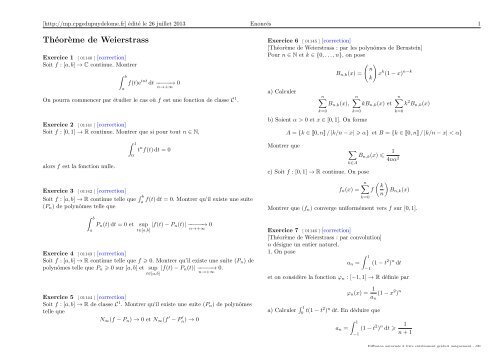
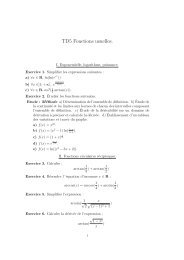
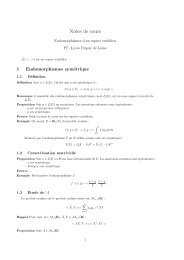
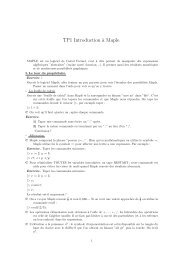

![[http://mp.cpgedupuydelome.fr] édité le 4 juin 2013 Enoncés 1 ...](https://img.yumpu.com/19249082/1/190x135/http-mpcpgedupuydelomefr-edite-le-4-juin-2013-enonces-1-.jpg?quality=85)
